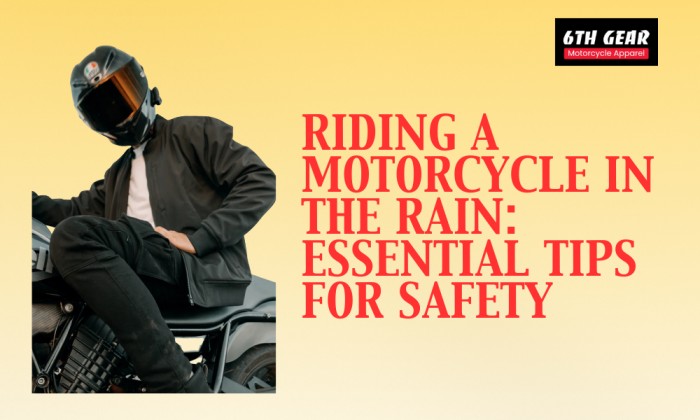Riding a Motorcycle in the Rain: Essential Tips for Safety and Comfort

Many riders will want to avoid travelling on a motorcycle in the rain, but it does not need to be a stressful exercise. The best motorcycle wet weather gear, proper attitude, and methods can make going through a particularly stormy day both safe and dry. It takes smoother driving, enhanced awareness, and the right preparations on your part and that of your bike to cruise on wet surfaces. A survival guide to riding in the rain: Learn how to ride in the rain safely without crashing and without getting a wet and cold butt; choose the best motorcycle rain suit to wear; know how to break smoothly and safely in the rain; find out how to stay dry and comfortably warm in the rain using a rain suit or protective rain suit; read how to stay safe and improve your riding skills when the rain comes out.
Why Riding in the Rain Isn’t as Risky as You Think
When the sky gets grey, numerous riders promptly park their bikes, as they think that it is always dangerous when rain appears. The fact is that with modern tyres, road, and riding styles, you still can have lots of traction. The major point is that it is not the problem of avoiding rain, but being able to cope with it. The ability to slow down and predict risks, and get your equipment ready, allows you to make a potentially stressful ride confident and controlled.
Shop the latest collection of motorcycle riding gear online and gear up for your next adventure with confidence.
Gear Up for Wet Weather
Safe wet-weather motorcycle riding is built on the best wet-weather motorcycle gear you can purchase. The water resistance is able to keep you dry and warm, and concentrate on the road as opposed to the pain caused by water.
The best motorcycle rain suit, that is, a one-piece or two-piece motorcycle rain suit, provides a protective cover against the elements. The one-piece seals better in heavy rain, and many riders opt to carry a two-piece so they can fit it to store it. Combine it with the finest motorcycle rain pants to protect your lower body, particularly in case you ride daily.
Never neglect the upper part of the body: wear the highest quality raincoat to ride a motorcycle that has a waterproof zipper, breathable material, and a tight collar. The equipment is rounded out with a helmet visor with anti-fog treatment, gloves, and waterproof boots. A simple trick is to ensure that you carry two Ziploc bags in your luggage or jacket pocket to help keep your phone, wallet, etc., dry.
Gear up with high-quality men’s motorcycle pants built for safety on the road and style off the bike.
Pre-Ride Checks Before Hitting the Wet Roads
Don’t rush off; remember to take a few minutes extra to prepare your bike for the conditions. Inspect tyre tread depths-deep grooves will aid in the release of water, and there is less risk of hydroplaning. Appropriate tyre pressure gives maximum grip. Have the brakes tested for responsiveness and check to ensure that there are no leaks that would deteriorate when it is wet.
The knowledge of grip location can guide you in taking safer routes on a road, as grip would most probably be on the rougher aggregate amid shining tar strips.
Beat the heat with a lightweight summer motorcycle vest designed for airflow, comfort, and essential protection.
Smart Riding Techniques for Rainy Conditions
In rainy situations on a motorcycle, smoothness is all that counts. The bike can be unnerved by sudden throttle, brake, or steering. The pace should be a little slower, and movements should be fluid.
With the brakes, apply the front and back sets of brakes progressively so the tyres can have consistent traction. Lean the motorcycle less by keeping it more upright during corners. Either make your following distance the extra space allows you more reaction time to deal with any sudden surprises.
Finding and Maintaining Grip
Just because something is wet doesn’t mean it has no grip, and you can even ride with confidence as long as you know where to get a grip. Avoid slippery surfaces such as painted lane markers, manhole covers, and fuel spills, which get so greasy when wet.
Where it is feasible, use the driest section of the lane as it will tend to provide a good grip. On roundabouts, drive at low speed and have your body in an upright position, making sure you monitor your oil patches or worn-out tarmac, which may make you slide.
Find the best bike riding pants USA riders trust for durability, comfort, and all-weather protection.
Dealing with Reduced Visibility
Rain not only affects traction, but it also reduces how much you and other drivers can see. Keep your visor clean and treated with anti-fog or water-repellent spray so droplets bead off quickly. Riding with your head slightly tilted can help the wind clear your visor.
Switch on your headlights to make yourself more visible and wear reflective details on your best motorcycle wet-weather gear for added safety.
Road Positioning and Hazard Awareness
Being vigilant is crucial. Do not ride near the roadway along the gutter where items and stagnant water accumulate. Rather, be centrally located in the channel where there is more traction.
One of the simplest, but at the same time, the most effective habits is the S.E.E. method. Always watch down the road to spot possible dangers, evaluate their severity, and either slow down or get out of the way.
Stay cool and protected on hot rides with breathable motorcycle mesh pants engineered for airflow and safety.
Post-Ride Care for You and Your Bike
After you get home, do not park your bike and forget it. Hang your best motorcycle rain pants and jacket so that they can dry fully. Clean the motorcycle off, including removing water spots and dirt on the road, especially in the parts of the bike where metal is exposed, to knock out corrosion.
Always re-check tyre pressure after the bike has cooled down because the PSI will vary with temperature. Grease the chain and the moving parts to guarantee excellent functioning of your bike on the next ride.
Ride in style and safety with durable motorcycle jeans with protection built for impact resistance and comfort.
Bottom Line
Last but not least, riding a motorcycle in the rain is not challenging the boundaries but is a matter of riding sensibly. Be prepared, have on the best motorcycle rain suit, and a proper attitude, you will be comfortable, safe, and in control regardless of how strong the downpour. Wet-weather riding develops skill and awareness, and how to properly read the road in a way dry conditions alone never could. When clouds come the next time, do not take it as an excuse to abort your journey. Rather, dress well in the finest rain trousers to use in riding motor bikes, keep yourself focused, and ride around to have the unique feeling of enjoying the open road under the rain.
















